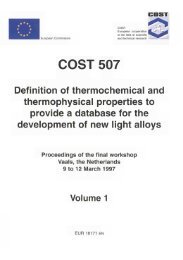Desenvolvimento de um sistema de troca automática do nozzle de ...
Desenvolvimento de um sistema de troca automática do nozzle de ...
Desenvolvimento de um sistema de troca automática do nozzle de ...
Create successful ePaper yourself
Turn your PDF publications into a flip-book with our unique Google optimized e-Paper software.
Abstract<br />
Abstract<br />
Development of an automatic <strong>nozzle</strong> changer for laser cutting machines<br />
This report focuses on the <strong>de</strong>velopment of an automatic cutting <strong>nozzle</strong> changer, which is<br />
inten<strong>de</strong>d to equip the Laser Cutting Centers of ADIRA S.A. The <strong>de</strong>velopment of<br />
this product resulted from the increasing need to reduce the setup times of the cutting<br />
centers and, therefore, improve the efficiency of work. Currently the <strong>nozzle</strong> exchange is<br />
a manual operation that requires <strong>de</strong> entry of an operator insi<strong>de</strong> the machine and, thus,<br />
it´s <strong>de</strong>activation, so the goal is to <strong>de</strong>velop an automated system to tighten/loosen<br />
quickly and efficiently the <strong>nozzle</strong> to the cutting head and, thus, <strong>de</strong>crease the effect of<br />
this operation on setup times.<br />
In or<strong>de</strong>r to solve this problem were shaped two distinct solutions. The first one consists<br />
on a rotating plate, whose operating principle is i<strong>de</strong>ntical to that of an automatic tool<br />
changer of the CNC machines. This dish as 24 holes, divi<strong>de</strong>d into two concentric tracks,<br />
which are inten<strong>de</strong>d to store the <strong>nozzle</strong>s and their respective supports. The rotation of the<br />
dish allows <strong>de</strong> transport of the <strong>de</strong>sired <strong>nozzle</strong> into a “Stand By” position, where are<br />
placed to stepper motors (one for each track) which transmit the rotation to the <strong>nozzle</strong><br />
hol<strong>de</strong>r and therefore allow the tightening/loosening of the <strong>nozzle</strong> in the cutting head.<br />
This solution was eventually aban<strong>do</strong>ned at an early stage of its <strong>de</strong>velopment, because it<br />
required the creation of a complicated coupling system between the motor shaft and the<br />
<strong>nozzle</strong> hol<strong>de</strong>r and the use of a very accurate motor to rotate the dish (splitter plate).<br />
To solve both of these problems it was mo<strong>de</strong>led a new solution, which was called<br />
drawer. This prototype has the tightening/loosening systems always in the same position<br />
and in constant contact with the motor, through a chain of straight toothed gears. As the<br />
exchange operation calls for a high torque control, sought to <strong>de</strong>termine the income<br />
losses in the chain and, therefore, calculate the torque difference between the first and<br />
the last tightening/loosening system. The results of this study led to the subdivision of<br />
the starting chain in three smaller ones, individually powered, which minimized the<br />
losses to only 10%.<br />
With the two prototypes completely mo<strong>de</strong>led, it was <strong>de</strong>ci<strong>de</strong>d that the second one was<br />
more simple and effective having then began its implementation into the cutting center.<br />
This phase led to the <strong>de</strong>velopment of a shield, a support and to the <strong>de</strong>finition of a drive<br />
system capable of carrying the cassette into the cutting area, which will be<br />
accomplished by a <strong>do</strong>uble acting pne<strong>um</strong>atic cylin<strong>de</strong>r.<br />
At the end, it was ma<strong>de</strong> an economic analysis to both solutions, having conclu<strong>de</strong>d that<br />
the cassette is approximately 3 times more expensive than the rotating plate. However,<br />
this result is not accurate because the utilization of the diving plate in the first solution<br />
would equalize the costs.<br />
v

















